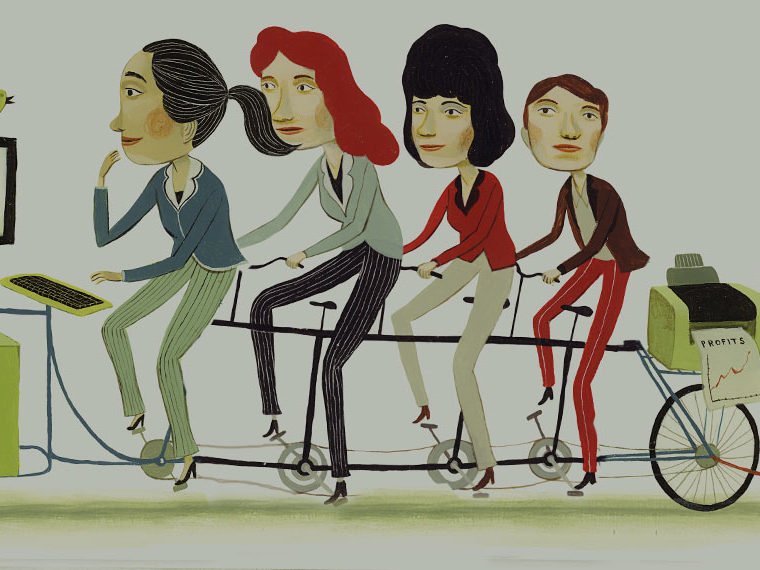Whether research shows benefits from diversity depends heavily on choice of study design
While debates rage on about whether diversity programs in college admissions and hiring practices are fair, some researchers are mulling diversity issues in more pointed productivity terms. In this field of study, the core questions are a little different from the headlines. Does having a lot of different ethnicities (or different industries, professions or demographics, for example) ramp up a city’s economic growth?
Do more diverse places — again under the broader definitions of “diverse” — generate more entrepreneurship or inventions?
Opt In to the Review Monthly Email Update.
The answers haven’t been particularly clear. Some studies find no connection between diversity and economic fortunes, while other empirical research points to strong benefits.
In work published in Research in Organizational Behavior, UCLA Anderson’s Olav Sorenson offers an explanation of why studies looking for economic effects from diversity often come to different, sometimes even contradictory, conclusions. He points to a technical issue in diversity study designs — one that researchers have typically treated as merely a “methodological inconvenience” — as an important determinant of whether a study will show benefits from diversity.
Reviewing decades of studies in the field, Sorenson notes that strong economic benefits from diversity rarely show up in those that focus on large areas, such as cities, regions or states. “Null” effects, in which no relationship between economic growth and diversity is found, are fairly common conclusions.
Conversely, studies that home in on smaller areas like neighborhoods, census tracts or one wing in an office building fairly consistently identify diversity benefits, sometimes impressively large ones.
The discrepancies arise, Sorenson proposes, because some of the strongest gains from diversity derive from unplanned, face-to-face meetings between people of different backgrounds. These encounters typically happen when people routinely share walkable spaces, like the hallways of office buildings, or the paths between home and the nearest subway station. Such close encounters are hard or even impossible to see in data that spans great distances.
Sorenson’s review suggests that the design issues many diversity researchers consider a mere bug in the analysis is actually an important determinant in study findings. Without an up close viewpoint — a certain “spatial resolution” in the study setup — some of the biggest benefits of diversity remain invisible.
Why Distance Matters
To understand the spatial resolution problem, imagine from-other-space-level views of New York City and Chicago with each resident within represented as a color-coded dot indicating ethnicity. As cities, both places will appear equally diverse. But zoom in, and the impression changes, Sorenson explains in the paper. Chicago is now “a quilt of ethnically uniform patches.” (In fact, large swaths of Chicago are overwhelmingly dominated by single ethnicities.) While New York City has homogeneous neighborhoods too, they are more scattered among a multitude of integrated neighborhoods.
While both views are accurate — both cities are among the most ethnically diverse in the country — they do not represent an equal level of day-to-day interaction between people of different backgrounds. It’s a lot more likely that a Chicagoan will spend a day without encountering ethnic variety than a New Yorker.
Now consider that almost all diversity studies are conducted from a single view — either the bird’s-eye version or the zoomed in kind, not both. Most take a city, county or even broader geographic area and analyze it “as if all the people and organizations within them sat on the head of a pin,” Sorenson writes. The data about individual people or firms is aggregated into one unit representing the average of the whole. The assumption, he explains, is that everyone within the defined area has an equal chance of diverse interactions.
Other studies focus on the actors rather than the region. One might look at the physical distance between individuals and others of different backgrounds. Or it might monitor actual movements to determine how frequently differing individuals cross paths.
For example, UCLA Anderson’s Keith Chen and MIT’s David Atkin and Anton Popov use cellphone data to look at how often employees of one firm are within conversation distance of workers from firms with different specialties. Another study out of the University of Michigan maps common office pathways to copiers, restrooms and elevators to determine the likelihood that different kinds of employees will meet.
Here’s how the two different approaches play out in some of the studies Sorenson cites in his analysis:
- Several studies in European countries found no relationship between a diversity of industries and regional economic growth. Sorenson notes that findings in other, similarly broad studies have suggested a slightly negative impact from industrial diversity, possibly because the different industries compete for workers.
- Finer scale studies have found that industrial diversity improves local productivity, but not necessarily city or regional productivity. One example: Plants located within 1 kilometer of plants in other industries reported higher productivity than those in adjacent homogenous areas.
- Numerous studies find that individuals who interact frequently with others of different expertise or demographics have better, often more lucrative, new ideas. The odds of producing breakthrough innovation or high-impact research rise greatly with diverse teams, and more patents come out of diverse communities, according to Sorenson’s lengthy citations.
- In a 2017 study, Sorenson and co-author Sampsa Samila (now with University of Navarra, Spain) find that venture capital dollars invested in ethnically diverse and integrated communities led to about 30% more jobs, startups and overall wealth than the same amount invested in segregated communities. On a more macro scale (metro areas), they found no connection at all between ethnic diversity and long-term economic growth.
Sorenson’s analysis suggests that the answer to the question, “how does diversity affect economic growth in New York and Chicago?” would depend heavily on which research approach is employed. Accordingly, the head-of-a-pin view might show limited but rather equal benefits in both cities. Up close, the findings would likely show that diversity is doing a lot more for the economy of New York City, the more definitive melting pot, than for Chicago.
Take a Closer Look
The fact that data from very small geographic areas consistently reveals much stronger benefits suggests that the value of diversity comes from unplanned exchanges that close proximity facilitates, Sorenson proposes. While diversity within an area the size of a city or commuting distance can be advantageous for filling jobs, or finding specialty partners, those are not distances that promote serendipitous encounters. Such happenstance meetings, which by definition have no pre-planned agendas, appear to be particularly good starting places for novel ideas, entrepreneurship and innovation.
Sorenson wants researchers to look more closely for these useful encounters and, in particular, ways to facilitate them. He notes that tools ranging from low-tech office maps to geolocation data from cellphones have already been proven useful for the job.
For example, a 2018 study by MIT’s Christian Catalini found that adjacent academic research departments were about 3.5 times more likely to collaborate than those separated by just a little more distance down the hall. His follow-on study with Harvard’s Maria P. Roche and Georgia Institute of Technology’s Alexander Oettl found that dissimilar startups exchange technologies frequently when they interact during social events sponsored by the co-working spaces they share, even if they don’t work right next to each other.
“When do streets and barriers create boundaries between neighborhoods?” Sorenson asks. What types of common spaces, such as cafes, parks and child care drop-offs, facilitate productive interactions? Where should everyone in the office sit?
It’s important, he writes, that study designs better capture the amount of time individuals actually spend close enough with others of different backgrounds to interact. Without such microgeographic study, the question of how regional disparities in innovation and economic growth relate to levels of diversity remains. The answers, he contends, are unlikely to be found by looking down at these encounters from space.
Featured Faculty
-
Olav Sorenson
Joseph Jacobs Chair in Entrepreneurial Studies; Professor of Strategy; Faculty Research Director, Price Center for Entrepreneurship & Innovation
About the Research
Sorenson, O. (2023). Does Diversity Influence Innovation and Economic Growth? It Depends on Spatial Scale. Research in Organizational Behavior, 100190.
Atkin, D., Chen, K.M., & Popov, A. (2022). The Returns to Face-To-Face Interactions: Knowledge Spillovers in Silicon Valley. (No. w30147). National Bureau of Economic Research.
Kabo, F. W., Cotton-Nessler, N., Hwang, Y., Levenstein, M. C., & Owen-Smith, J. (2014). Proximity effects on the dynamics and outcomes of scientific collaborations. Research Policy, 43(9), 1469–1485.
Andersson, M., Larsson, J. P., & Wernberg, J. (2019). The economic microgeography of diversity and specialization externalities – firm-level evidence from Swedish cities. Research Policy, 48(6), 1385–1398.
Catalini, C. (2018). Microgeography and the direction of inventive activity. Management Science, 64(9), 4348–4364.
Roche, M., Oettl, A., & Catalini, C. (2022). (Co-)working in close proximity: Knowledge spillovers and social interactions. (No. w30120). National Bureau of Economic Research.






